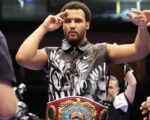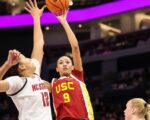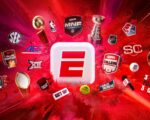In an era when college basketball teams are increasingly reliant on the transfer portal to recruit more experienced players — and less interested in stockpiling one-and-done recruits, with the expectation of Duke — having raw talent with pro upside on a roster still matters.
Last season’s national title team at Florida featured first-round 2025 NBA Draft pick Walter Clayton Jr., two second-rounders (Alijah Martin and Will Richard) and two more projected 2026 first-rounders (Alex Condon and Thomas Haugh). UConn’s back-to-back champs produced six total NBA draft picks, with one more in the pipeline (Alex Karaban).
All of that to say: It’s no surprise that most of the 2026 title contenders find themselves on this season’s list of teams with the most NBA talent, based on ESPN’s NBA draft big board.
Preseason No. 1 Purdue is the notable exception. The Boilermakers have two players — Braden Smith (No. 33) and Trey Kaufman-Renn (No. 94) — featured in the top 100, but that wasn’t enough to make the cut based on our methodology (more on that below). Will that matter in their quest to win the program’s first national title? Matt Painter has long been a proponent of retention and continuity, it’s brought the program plenty of success, and he’s betting on it again this season. We’ll find out in five months if he’s right.
It’s also worth noting the team with the projected No. 1 pick, Kansas and Darryn Peterson, didn’t make the cut. While NBA teams will flock to evaluate the Jayhawks all season, they ultimately have only one other player in Flory Bidunga (No. 64) on the big board.
Now let’s dive into the top 10 teams with the most future NBA talent as ranked by ESPN’s NBA draft analyst Jeremy Woo and college basketball reporter Jeff Borzello, who weighted top-50 prospects more heavily in the formula and gave an extra boost to teams that featured lottery picks and elite-level prospects.

![]()
Top-50 players: Cameron Boozer (No. 3), Dame Sarr (No. 10), Isaiah Evans (No. 20), Patrick Ngongba II (No. 27), Nikolas Khamenia (No. 34)
Other pro prospects: Cayden Boozer, Sebastian Wilkins
While we may not see the Blue Devils produce three lottery picks after sending Cooper Flagg (No. 1), Kon Knueppel (No. 4) and Khaman Maluach (No. 10) to the NBA at the top of this last summer’s draft, Jon Scheyer’s team is built around a new prodigious freshman centerpiece in Cameron Boozer.
Boozer is arguably the most college-ready player in the freshman class and could be in the running for National Player of the Year as he jockeys for the No. 1 pick. His mix of physical strength, advanced skill and sublime basketball IQ make him an excellent long-term prospect.
The rest of Duke’s roster is plenty talented, but still developing. Sarr has lottery potential and long-term pro appeal as a jumbo wing with real defensive chops. Khamenia brings 3-point shooting and size to the frontcourt, but it’s unclear exactly how fast his NBA track will be. Boozer’s twin brother, Cayden, projects as more of a multi-year college player and opens the season behind Foster in the guard rotation.
There’s returning talent as well, with Evans looking to prove he can score with more consistency as he steps into a starting role. His bucket-getting ability creates a pathway to the NBA with continued improvement. Ngongba should build on the flashes he showed as a freshman, with an attractive mix of size, offensive skill and versatility.
This team should ultimately go as far as Cam Boozer can carry them. — Woo
![]()
Top-50 players: Chris Cenac Jr. (No. 7), Joseph Tugler (No. 23), Kingston Flemings (No. 37), Isiah Harwell (No. 45)
Other pro prospects: Milos Uzan (No. 55), Emanuel Sharp (No. 89)
Kelvin Sampson and the Cougars have won through continuity, identifying players who fit their gritty ethos and generally retaining those players long enough to see their development pay off.
That recipe looks a little bit different this season with freshmen Cenac, Harwell and Flemings all slated for significant roles. All three have NBA potential, but are still a ways from impacting a game at that level. There might be some growing pains as the season goes on, but Cenac has the highest ceiling of the group as a skilled big who can also protect the basket. Sampson will be tasked with toughening him up, and how quickly Cenac takes to the college game will be a determinant in this team’s ceiling. Harwell offers nice size on the wing and 3-and-D potential, while Flemings is regarded as the most college-ready of the trio with his playmaking. Still, neither Harwell or Flemings are considered surefire one-and-dones.
The good news is that Houston returns a trio of battle-tested starters in Tugler, Uzan and Sharp. Tugler’s toughness and defensive mentality gives him long-term NBA role player appeal, but his limited offensive impact makes him a bit of an acquired taste. He could play his way into the first round with a monster season. Uzan should again be one of the better floor generals. And Sharp is an excellent long-range marksman. Another deep March run would help bolster their standings. — Woo
![]()
Top-50 players: Koa Peat (No. 8), Dwayne Aristode (No. 32), Brayden Burries (No. 41), Motiejus Krivas (No. 49)
Other pro prospects: Ivan Kharchenkov (No. 52), Jaden Bradley (No. 100), Sidi Gueye
Tommy Lloyd and the Wildcats have multiple potential first-round picks hoping to follow in Carter Bryant’s one-and-done footsteps.
Five-star recruits Peat and Burries could fit that bill, with both already seeing heavy usage through two games. Peat can do a little bit of everything as a 6-foot-8, 235-pound forward. Burries is a big-time scorer who is physically ready for the college game. The question for both prospects is whether they have the explosiveness to make an impact in the NBA. Peat began to answer that with a 30-point, 7-rebound, 5-assist performance against reigning champion Florida on opening night.
Two more newcomers — Aristode and Kharchenkov — don’t have the same defined roles as Peat and Burries, but will battle for minutes on the wing. Aristode immediately jumps out from an NBA perspective as a 3-and-D asset, while Kharchenkov became the youngest player in Bundesliga history when he made his debut for Bayern Munich as a 16-year old in 2022.
Krivas played in just eight games last season before missing the rest of the campaign with a foot injury, but the 7-foot-2 center and former projected first-round pick is back on the floor. He is a terrific defensive player who has shown flashes offensively. — Borzello
1:18
Florida Gators vs. Arizona Wildcats: Game Highlights
Florida Gators vs. Arizona Wildcats: Game Highlights
![]()
Top-50 players: Braylon Mullins (No. 12), Alex Karaban (No. 40)
Other pro prospects: Eric Reibe (No. 53), Solo Ball (No. 59), Tarris Reed Jr., Jaylin Stewart, Silas Demary Jr.
Dan Hurley and UConn have produced four first-rounders and seven draft picks in the last three years, and the Huskies are on track for more after reloading the roster to compete for a third national title in four years.
Mullins could be the program’s third straight one-and-done first-rounder. He was arguably the best shooter in the 2025 recruiting class and has shown the ability to get to the basket if defenses close out too aggressively or crowd him too much on the perimeter. He suffered a sprained ankle in late October, though, and is out until December.
Karaban opted against rolling the dice as a borderline first-round pick in the past two drafts, and should be more comfortable as a focal point of the UConn offense this season. He made strides as more than just a catch-and-shoot stretch forward last season, and the arrivals of Mullins and Demary should help him.
Ball broke out as a sophomore, going from 3.3 points and 31.9% 3-point shooting in 2024-25 to 14.4 and 41.4% marks last season. He needs to show more off the dribble, but if he takes a similar jump this season, he could play himself into the All-American conversation.
Stewart is another name to monitor, especially if he can generate some momentum while filling in for Mullins, while Reibe is showing flashes early. — Borzello
![]()
Top-50 players: Darius Acuff Jr. (No. 16), Meleek Thomas (No. 26), Karter Knox (No. 38)
Other pro prospects: Trevon Brazile, D.J. Wagner, Billy Richmond III, Malique Ewin
Arkansas has a deep stable of potential prospects, despite lacking the clearcut lottery picks other teams on this list possess.
In typical John Calipari fashion, he brought in a pair of five-star guards who have the talent to go one-and-done. Acuff is the type of point guard Calipari loves to hand the ball to, and did to start this season — he’s an explosive playmaker as a scorer and distributor. And while Thomas is coming off the bench, he’s a terrific scorer. Fine-tuning his shot selection is the main area for improvement.
Knox is the highest-ranked of Arkansas’ non-freshmen prospects after the former five-star recruit moved into the starting lineup last December and finished the season on a tear. He’ll have to show more as a perimeter shooter, but he’s made strides in that department since high school.
Wagner and Brazile have been on draft boards for years, Billy Richmond is looking to move himself up on them. — Borzello
![]()
Top-50 players: Thomas Haugh (No. 14), Alex Condon (No. 29)
Other pro prospects: Boogie Fland (No. 54), Xaivian Lee (No. 86), CJ Ingram
Florida should have more than enough on the roster to mount a proper title defense after retooling the backcourt with transfers Fland and Lee.
Haugh and Condon give the Gators a considerable backbone in the frontcourt, allowing them to play big, skilled lineups. After drawing interest in the 2025 draft, both are better positioned for 2026.
Haugh’s ability to play both forward spots as a plus passer and rebounder makes him an appealing long-term role player, though his advanced age (22) and average 3-point shooting (34% last season) could cap how teams view his upside. Still, he’s a quick processor who looks like a strong first-round bet.
The hope is Condon will be able to make a more consistent offensive impact this season. NBA evaluators appreciate his playmaking feel, motor and mobility operating in the middle of the floor. Showcasing a more consistent 3-point shot would help his projection, but his defense gives him a solid base for a rotational center as he continues to polish his skills.
Fland and Lee are smaller guards who will have to further prove themselves. Fland played just 21 games at Arkansas last season due to injuries while Lee faces a big leap into the SEC after three seasons at Princeton. Fland’s playmaking and Lee’s 3-point shooting will be key to Florida’s offense, though, and big campaigns could improve their NBA hopes. — Woo
![]()
Top-50 players: Jayden Quaintance (No. 9)
Other pro prospects: Otega Oweh (No. 76), Jaland Lowe (No. 84), Kam Williams, Brandon Garrison, Jasper Johnson, Malachi Moreno, Mouhamed Dioubate
A fully-healthy Kentucky team should be one of the deepest in the country, with Quaintance the primary prospect to watch. The Wildcats have a wide range of players with pro potential, but most project as second-rounders or back-end roster types at this stage.
Quaintance is slated to return mid-season after tearing his ACL in February, transferring from Arizona State after entering college a year early. The 18-year-old center showcased intriguing potential last season and piqued NBA interest while racking up steals (1.1 SPG) and blocks (2.6 BPG). Scouts will be eager for his return to get a better sense of his projection on the offensive end as a rim-runner and vertical spacer. Improving his jump shot will be pivotal, but his strong frame, huge wingspan and noteworthy defensive impact give him a pathway to the lottery.
Oweh and Lowe are Kentucky’s most experienced perimeter players. Oweh’s unorthodox shooting mechanics will be a tough sell for a lot of scouts, but his energy, defense and athleticism make him a prospect nonetheless. Lowe is a touch undersized at 6-1 and 170 pounds, but offers playmaking instincts and on-ball pace at the point. He’ll be a huge component on a team that’s otherwise light on creators.
0:16
Otega Oweh fights off multiple defenders for a nice Kentucky bucket
Otega Oweh fights off multiple defenders for a nice Kentucky bucket
It will be curious to see which of Kentucky’s other players progress this season, and whether any can accelerate their pathways to the NBA — Williams may be the most intriguing long-term, after a strong freshman year at Tulane. — Woo
![]()
Top-50 players: Yaxel Lendeborg (No. 15), Aday Mara (No. 30)
Other pro prospects: Morez Johnson Jr. (No. 60), Trey McKenney, L.J. Cason, Elliot Cadeau, Malick Kordel
If there’s one thing we know about Dusty May, it’s that he’s not afraid of unique frontcourt combinations. He showed it last season by starting 7-footers Danny Wolf and Vladislav Goldin next to each other, using Wolf as a playmaking fulcrum of Michigan’s offense. With both players gone, May brought in three legitimate NBA prospects via the portal in Lendeborg, Mara and Johnson.
Lendeborg — one of the most productive frontcourt players in the country the last two seasons at UAB — opted to return to college despite being projected as a first-round pick down the stretch of the 2025 draft process. May has been raving about deploying Lendeborg in creative ways, even classifying him as a guard at Big Ten Media Day.
Mara generated significant preseason buzz and is expected to build on the flashes he showed the last two seasons at UCLA. Johnson was one of the most efficient bigs in the country last season as a freshman at Illinois before a broken wrist slowed him down.
Five-star freshman McKenney is a powerful perimeter scorer, while Cason has been pegged as a sleeper prospect the last two preseasons. — Borzello
![]()
Top-50 players: Tomislav Ivisic (No. 36)
Other pro prospects: Andrej Stojakovic (No. 68), Kylan Boswell (No. 75), Zvonimir Ivisic (No. 90), Keaton Wagler, David Mirkovic, Mihailo Petrovic
Illinois leaned heavily into the international route when putting this roster together and will have a brand-new look after sending Kasparas Jakucionis and Will Riley into the NBA as one-and-done freshmen.
Tomislav Ivisic has growing NBA intrigue, with scouts hoping to see him build on last season — his sheer size, ability as a passer and efficient scoring give him role player potential long-term. His twin brother Zvonivir joins Illinois after transferring from Arkansas, and could be in the second-round picture if he can find better consistency.
Stojakovic transferred from Cal, giving the Illini an experienced wing to pair with Boswell, who returns for his senior season. Both have NBA role potential, but need strong seasons to firm up their positions. Illinois will need them both to score at a high level.
NBA teams are also keeping an eye on unheralded freshman guard Wagler, who is viewed as a longer-term prospect but has impressed so far with his unselfishness and feel. He could wind up sticking as a starter if he adjusts smoothly. — Woo
![]()
BYU’s Top-50 players: AJ Dybantsa (No. 2)
BYU’s other pro prospects: Richie Saunders (No. 70), Robert Wright III, Xavion Staton
Kevin Young has made BYU a legitimate threat on the recruiting trail since taking charge in Provo, with No. 1 incoming freshman Dybantsa the crown jewel of the Cougars’ roster-building efforts over the last two seasons. Young has built a potential Final Four contender, and if that potential is realized, Dybantsa will be at the center of it.
0:19
AJ Dybantsa throws down powerful dunk vs. Holy Cross Crusaders
AJ Dybantsa gets up for the beautiful dunk
The 6-9 wing is a truly elite offensive player, capable of scoring at all three levels and getting his own shot against nearly any defender in the sport. He is an underrated passer and pick-and-roll operator who is unstoppable in the open floor. When locked-in defensively, he can guard multiple positions and be a playmaker at that end of the floor, too.
Surrounding Dybantsa on the perimeter is Saunders and Baylor transfer Wright. The 24-year-old Saunders broke out as an offensive focal point in 2024-25 and his 3-point shooting ability should be even more effective with Dybantsa taking the attention of opposing defenses. Wright is running the show, and he’ll have the opportunity to showcase more to NBA evaluators. He’s only 6-1 and made fewer than one 3 per game last season, but he’s a high-level playmaker who has been surrounded by elite talent for most of the last few seasons.
Staton might be a year away, but he should make an early impact on the defensive end as a rim protector. The offseason buzz out of Provo was positive. — Borzello














